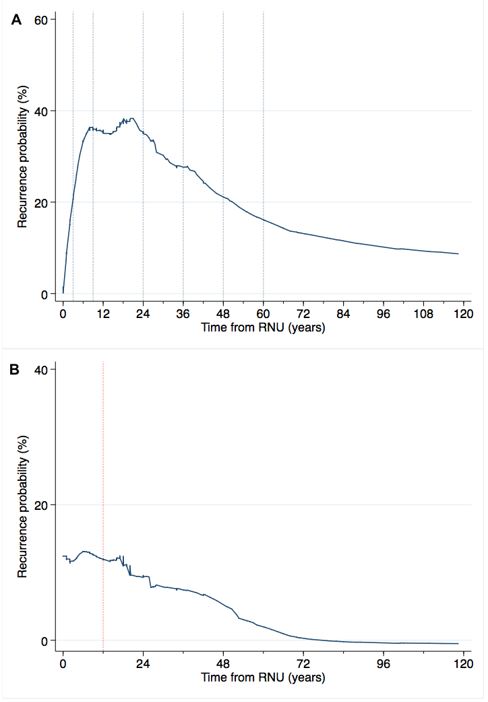Back
Poster, Podium & Video Sessions
Podium
PD58: Bladder Cancer: Upper Tract Transitional Cell Carcinoma II
PD58-10: Implementing the follow-up Schedule after radical nephrouretrectomy for low risk upper tract urothelial carcinoma
Monday, May 16, 2022
2:30 PM – 2:40 PM
Location: Room 252
Alberto Martini*, Riccardo Leni, Giuseppe Basile, Simone Scuderi, Mario De Angelis, Luigi Nocera, Giuseppe Rosiello, Milan, Italy, Chiara Lonati, Luca Afferi, Lucerne, Switzerland, Giorgio Gandaglia, Milan, Italy, Andrea Gallina, Lugano, Switzerland, Pierre Karakiewicz, Montreal, Canada, Shahrokh Shariat, Vienna, Austria, Francesco Montorsi, Alberto Briganti, Marco Moschini, Milan, Italy
Podium Presenter(s)
Introduction: The current EAU follow-up for surgically-treated low risk upper tract urothelial carcinoma (LR UTUC) entails cystoscopies at 3 and 9 month and yearly thereafter till the 5th. On the premise that the risk of recurrence in the contralateral kidney is non-negligible and no recommendation is provided by the current EAU guidelines on performing imaging or ureteroscopy during follow-up, we aimed to provide data-driven recommendation to evaluate whether the current follow-up scheme for LR UTUC should be implemented
Methods: We identified 204 patients with LR UTUC treated with radical nephroureterectomy from a multi-institutional database. Patients were followed up according to EAU guidelines and recurrences in the contralateral kidney or ureter were investigated in case of symptoms or hematuria through imaging and/or ureterorenoscopy. The crude risk of recurrence was evaluated against time from RNU with the Locally Weighted Scatterplot Smoothing. Patients were stratified based on their prior history of UC
Results: Median Follow-up for survivors was 39 months, 74% were male. A total of 68% patients had pTis/a and 32% patients had pT1 disease. Overall, there were 55 bladder recurrences and 17 in the contralateral kidney. Figure 1A displays the risk of bladder recurrence. Vertical lines correspond to the time points when cystoscopies should be performed. At 5-year, time point after which cystoscopies should be interrupted, the risk of bladder recurrence was slightly less than 20% and kept decreasing. Figure 1B displays the risk of recurrence in the contralateral kidney or ureter. At -year the risk of recurrence was approximately 10%
Conclusions: The surveillance pattern, in terms of cystoscopies, for the detection of bladder recurrence after RNU mirrors the one for low risk non-muscle-invasive bladder cancer. We found that this scheme should not be applied to LR UTUC since a high risk of bladder recurrence persists even after 5 years and urologists should counsel patients on undergoing cystoscopy beyond this time point. Additionally, one should obtain imaging or perform ureterorenoscopy at 12 months after RNU as part of the surveillance scheme for the timely detection of contralateral kidney recurrence
Source of Funding: no

Methods: We identified 204 patients with LR UTUC treated with radical nephroureterectomy from a multi-institutional database. Patients were followed up according to EAU guidelines and recurrences in the contralateral kidney or ureter were investigated in case of symptoms or hematuria through imaging and/or ureterorenoscopy. The crude risk of recurrence was evaluated against time from RNU with the Locally Weighted Scatterplot Smoothing. Patients were stratified based on their prior history of UC
Results: Median Follow-up for survivors was 39 months, 74% were male. A total of 68% patients had pTis/a and 32% patients had pT1 disease. Overall, there were 55 bladder recurrences and 17 in the contralateral kidney. Figure 1A displays the risk of bladder recurrence. Vertical lines correspond to the time points when cystoscopies should be performed. At 5-year, time point after which cystoscopies should be interrupted, the risk of bladder recurrence was slightly less than 20% and kept decreasing. Figure 1B displays the risk of recurrence in the contralateral kidney or ureter. At -year the risk of recurrence was approximately 10%
Conclusions: The surveillance pattern, in terms of cystoscopies, for the detection of bladder recurrence after RNU mirrors the one for low risk non-muscle-invasive bladder cancer. We found that this scheme should not be applied to LR UTUC since a high risk of bladder recurrence persists even after 5 years and urologists should counsel patients on undergoing cystoscopy beyond this time point. Additionally, one should obtain imaging or perform ureterorenoscopy at 12 months after RNU as part of the surveillance scheme for the timely detection of contralateral kidney recurrence
Source of Funding: no

.jpg)
.jpg)
